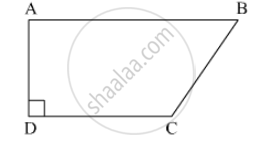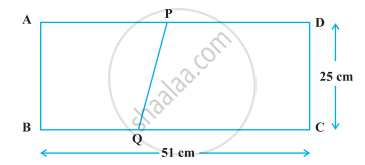Advertisements
Advertisements
प्रश्न
Prove that the points A (a,0), B( 0,b) and C (1,1) are collinear, if `( 1/a+1/b) =1`.
उत्तर
Consider the points A (a,0), B( 0,b) and C (1,1) .
` Here (x_1=a,y_1=0).(x_2 = 0,y_2=b) and (x_3=1,y_3=1).`
It is given that the points are collinear. So,
`x_1 (y_2-y_3)+x_2(y_3-y_1) +x_3(y_1-y_2) =0`
`⇒ a(b-1)+0(1-0)+1(0-b)=0`
`⇒ ab-a-b=0`
Dividing the equation by ab:
`⇒ 1-1/b-1/a=0`
`⇒ 1-(1/a+1/b)=0`
`⇒(1/a+1/b)=1`
Therefore, the given points are collinear if `(1/a+1/b)=1`
APPEARS IN
संबंधित प्रश्न
If A(−4, 8), B(−3, −4), C(0, −5) and D(5, 6) are the vertices of a quadrilateral ABCD, find its area.
Find the area of the triangle PQR with Q(3,2) and the mid-points of the sides through Q being (2,−1) and (1,2).
Prove that the points (a, b + c), (b, c + a) and (c, a + b) are collinear
Let A (4, 2), B (6, 5) and C (1, 4) be the vertices of ΔABC.
(i) The median from A meets BC at D. Find the coordinates of point D.
(ii) Find the coordinates of the point P on AD such that AP: PD = 2:1
(iii) Find the coordinates of point Q and R on medians BE and CF respectively such that BQ: QE = 2:1 and CR: RF = 2:1.
(iv) What do you observe?
(v) If A(x1, y1), B(x2, y2), and C(x3, y3) are the vertices of ΔABC, find the coordinates of the centroid of the triangle.
The area of a triangle is 5 sq units. Two of its vertices are (2, 1) and (3, –2). If the third vertex is (`7/2`, y). Find the value of y
Find the angle subtended at the origin by the line segment whose end points are (0, 100) and (10, 0).
If G(-2, 1) is the centroid of a ΔABC and two of its vertices are A(1, -6) and B(-5, 2) , find the third vertex of the triangle.
In ☐ABCD, l(AB) = 13 cm, l(DC) = 9 cm, l(AD) = 8 cm, find the area of ☐ABCD.

Find the area of the triangle whose vertices are (–8, 4), (–6, 6) and (–3, 9).
The dimensions of a rectangle ABCD are 51 cm × 25 cm. A trapezium PQCD with its parallel sides QC and PD in the ratio 9 : 8, is cut off from the rectangle as shown in the following figure. If the area of the trapezium PQCD is `5/6` th part of the area of the rectangle, find the lengths QC and PD.

